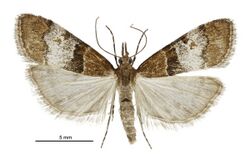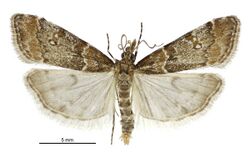Biology:Antiscopa acompa
| Antiscopa acompa | |
|---|---|

| |
| Female | |

| |
| Male | |
| Scientific classification | |
| Domain: | Eukaryota |
| Kingdom: | Animalia |
| Phylum: | Arthropoda |
| Class: | Insecta |
| Order: | Lepidoptera |
| Family: | Crambidae |
| Genus: | Antiscopa |
| Species: | A. acompa
|
| Binomial name | |
| Antiscopa acompa (Meyrick, 1884)[1]
| |
| Synonyms[2] | |
| |
Antiscopa acompa is a moth in the family Crambidae.[3] It was first described by Edward Meyrick in 1884. It is endemic to New Zealand and is found both the North and South Islands. The species inhabits native forest and adult moths are attracted to light.
Taxonomy
This species was first named Scoparia acompa by Edward Meyrick in 1884.[4][2] In 1885 Meyrick gave a detailed description of the species using specimens collected near Lake Wakatipu at 1,200 feet.[5] George Hudson discussed and illustrated this species under the name Scoparia acompa in his 1928 book The butterflies and moths of New Zealand.[6] In 1964 Eugene Munroe placed this species in the genus Antiscopa.[7] This placement was accepted by John S. Dugdale in 1988.[2] The male holotype, collected at Lake Wakatipu, is held at the Natural History Museum, London.[2]
Description
In 1885 Meyrick gave a detailed description of the species as follows:
Male. — 17 1⁄2-19 mm. Head, antennae, and thorax ochreous-fuscous, shoulders suffusedly dark fuscous ; antennas deeply dentate, ciliations 2⁄3. Palpi 3, ochreous-fuscous irrorated with blackish, internally and on basal joint white. Abdomen whitish-ochreous. Legs whitish-ochreous, irrorated with dark fuscous, tibiaa and tarsi banded with dark fuscous. Forewings triangular, costa gently arched, apex round-pointed, hindmargin almost straight, oblique ; ochreous-fuscous ; base irrorated with dark fuscous ; first line very slender, obscure, whitish, posteriorly finely blackish-margined, not oblique, somewhat curved, sinuate inwards above inner margin ; space between first and second lines fuscous, irrorated with dark fuscous, with a few pale scales ; orbicular and claviform both round, ochreous-brown, obscurely blackish-margined, touching first line ; reniform 8-shaped, white, suffusedly blackish-margined; second line very slender, obscure, whitish, anteriorly finely blackish-margined, rather abruptly curved above middle ; subterminal obsolete ; a slender interrupted white hindmarginal line : cilia ochreous-whitish, witb two dark grey lines. Hindwings 1 1⁄3, whitish-grey ; lunule, postmedian line and a hindmarginal line darker grey, distinct ; cilia whitish, with a dark grey interrupted line.[5]
Meyrick regarded this species as distinctive as a result of its forewing colouration and markings.[5] However this species is very similar in appearance to Antiscopa epicomia but can be distinguished as A. acompa has a thicker antemedian forewing line.
Distribution
This species is endemic to New Zealand.[8][1] It has been collected in both the North and South Islands.
Habitat
This species inhabits native forest.[6]
Behaviour
Adults have been recorded on wing from October to February.[5][9] Adults of this species are attracted to light.
References
- ↑ 1.0 1.1 , p. 458, Wikidata Q45922947
- ↑ 2.0 2.1 2.2 2.3 , pp. 154, Wikidata Q45083134
- ↑ "Antiscopa acompa (Meyrick, 1884)". 21 July 2015. https://biotanz.landcareresearch.co.nz/scientific-names/da71a3c0-f066-4a3c-9065-b56f358232ec.
- ↑ , pp. 236, Wikidata Q113372586
- ↑ 5.0 5.1 5.2 5.3 , pp. 100-101, Wikidata Q113379604
- ↑ 6.0 6.1 , pp. 195, Wikidata Q58593286
- ↑ , Wikidata Q115118913
- ↑ "Antiscopa acompa (Meyrick, 1884)". Landcare Research New Zealand Ltd. 23 December 2014. http://www.nzor.org.nz/names/79645ebf-981d-47ef-969c-bfef82f3397f.
- ↑ "Antiscopa acompa" (in en). https://www.inaturalist.org/taxa/385787-Antiscopa-acompa.
Wikidata ☰ Q13380535 entry
 |




